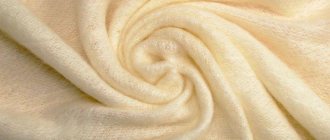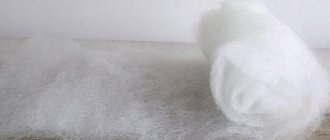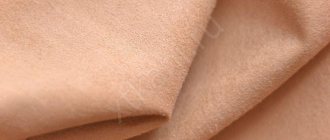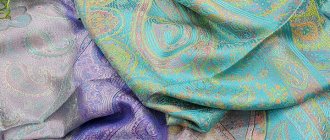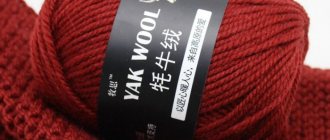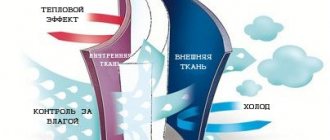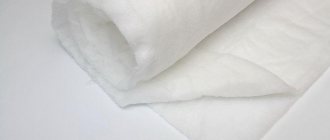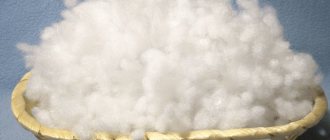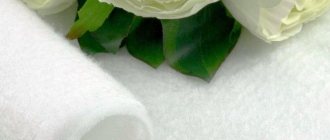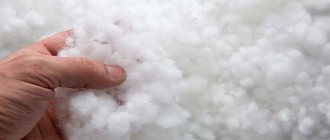What kind of material
Sherstipon is a Russian-made insulation material. It is an improved type of padding polyester. The filler can also be found on sale under the names: shersikon, shervisin, shersikron.
The new generation of insulation is warmer than its predecessor, padding polyester. It is superior in heat-preserving functions to holofire. While woolpon is not inferior to Thinsulate in its warming qualities, it is inferior in water-repellent properties.
The material compares favorably with elasticity and plasticity from batting. It is also more durable and not subject to deformation.
On average, a product with wool-pon filler lasts at least 6–7 years. With Thinsulate – up to 10 years, and with classic synthetic padding – about 3 years.
Woolstipon or padding polyester
Both materials are lightweight, with good air permeability, have a similar structure, composition and scope of application. But there are still differences.
Widespread and versatile, synthetic winterizer is a non-woven fabric made of polyester fibers, which are held together by an adhesive component or temperature exposure. The volumetric structure, saturated with air, retains heat and is elastic. The advantages of synthetic winterizer are availability and low price.
However, it has low heat-saving properties, designed for the off-season and slight cold snaps, so it is not used for winter clothing, but wool wool is intended for frosty days.
Sintepon recovers less well when compressed and does not hold its shape well. After a short period of use, there is a displacement of the fibers, lumps appear and it gets knocked down. Moisture reduces the volume by almost half the thickness.
Synthetic winterizer contains an adhesive composition and is not suitable for people suffering from allergies or asthma, while woolen polyester is environmentally friendly. It is considered to be of higher quality and more durable, which is why it costs more.
Composition and properties
The composition of woolpon includes natural sheep or camel, less often goat wool and hollow polyester fibers. The percentage varies depending on the manufacturer's specifications. The regulated amount of wool is at least 50%. Most often this figure is in the range of 60 – 70%.
The material is produced using one of two technologies: needle-punched or thermal bonding. Depending on the purpose, the insulation can be of different densities (100 g/m2, 150 g/m2, 200 g/m2, 300 g/m2, 600 g/m2).
So I use 200 g/m2 woolpon for sewing outerwear, and for blankets – 100 – 150 g/m2. To insulate jackets and coats, woolpontons with lining are produced, and quilted ones are more often used for the production of bedspreads and blankets.
Casual outerwear with wool wool is designed for frost down to minus 30°C. Manufacturers of sports equipment and outdoor clothing use denser wool wool (from 300 to 600 g/m2). The equipment is capable of heating at air temperatures down to minus 40°C.
Provided that the wool has gone through all stages of cleaning and processing, the color of the woolpona is white or beige.
Possible disadvantages of sherstepon
If the insulation is made with high quality, has undergone good cleaning and antistatic treatment, no negative properties are detected. If the technology is violated, the resulting product may not satisfy consumers.
- As a result of poor bonding, the insulation may become prone to deformation.
- If fibers are poorly washed, allergic reactions may subsequently appear.
- If processed incorrectly, the material can produce static electricity, since both initial components initially have this property.
- If the material contains a lot of wool and has not undergone special treatment, the appearance of moths in it cannot be completely ruled out.
Attention! Possible shortcomings appear during unprofessional manufacturing.
Application area
Sherstipon is used in the production of outerwear (coats, down jackets, fur coats). It is also used to make home textiles and sports equipment.
The material is used to insulate women's, men's, and children's clothing. It is used as a quilted lining for winter coats or jackets.
The filler has proven itself well in suits for active winter recreation. They also fill sleeping bags with it.
Insulation for clothing is used for the production of hats. Most often these are hats for children.
Woolstipone is used as a filler for mattresses. But blankets with this filling have become more widespread. It is also used for stuffing pillows or sewing voluminous, quilted bedspreads. Thanks to the ecological purity of raw materials, children's blankets are produced from woolpon.
Good old batting
Page content. However, there are many industries where practical and reliable batting still remains unbeatable. Like many other types of textiles, this heat-insulating material began to be produced in France, the literal translation of the word ouatine - fleece. In search of a cheap replacement for the traditional fur lining of winter clothing of the time, a non-woven material was invented, consisting of cotton or wool wadding attached to a mesh fabric.
What keeps clothes warm in cold weather? This necessary work for us is performed by air, so the main property of all insulation is the ability to trap air under clothing near the body and preserve its temperature.
Care
Items made with wool wool are easy to care for. Products with this filling can be washed. It is important to follow simple rules:
- the water temperature should not exceed 35°C;
- detergents are chosen without aggressive components. Bleaching agents are prohibited;
- when washing in a machine, choose a delicate cycle, with spin at low speeds or without it at all;
- When washing by hand, the products are not soaked, and when wrung out, do not twist them too much;
- dry outerwear by hanging them on hangers. Home textiles are placed on a horizontal surface in a straightened form;
- Ironing and drying near heat sources are not recommended.
Due to the wool content in the insulation, it is recommended to treat the product with anti-moth agents before storing.
Dear readers of the Tkan.Club website, if you still have questions on this topic, we will be happy to answer them. Leave your reviews, comments, share stories if you have dealt with this material! Your life experience may be useful to other readers.
Reviews
Shervisin has mostly positive reviews, as it has advantages over other natural and synthetic insulation materials. Despite the lightness of the material, it retains heat perfectly, does not retain excess moisture that our body produces, therefore, it is not hot in warm weather, but warm in sub-zero temperatures. The material is much softer than padding polyester, but differs from it in gray-yellow color.
You can encounter negative reviews when purchasing low-quality material from irresponsible manufacturers. With this option, the fabric manufacturing technology is violated. It may crumble or cause an allergic reaction from the body.
Wool
This thermal insulation is made from sheep wool processed in a special way. The thickness of the canvas is 2-12 cm and has different densities. The material has a number of advantages:
- Absorbs up to 25% of its weight in moisture. This property allows you to regulate the level of humidity in the room. If the air becomes too dry, the wool will release water. Therefore, wool is laid without a vapor-permeable membrane.
- It is used for finishing partitions, walls, ceilings, and inter-rafter spaces. With the frame construction method, wool is placed between sheets of chipboard.
- Wool insulation is lightweight.
- Some wool insulation contains antiseptics that repel insects.
- Imported materials are treated with fire retardants.
The disadvantage of this insulation is the need for treatment with fire retardants and antiseptics. This reduces the positive environmental qualities of the material. Rodents live in wool.
People can be allergic to wool. Therefore, when the first signs of the development of the disease appear, it is necessary to remove the thermal insulation and redo the repairs. Otherwise, asthma may gradually develop.
Basic tips when choosing insulation for sewing clothes
Children jumpsuits:. Down is a mixture of down and feathers of waterfowl. Fill Power is the ratio of the volume occupied by down to its weight. The higher this indicator, the less fluff is needed for insulation and the better the ratio of retained heat to weight becomes. The best down is considered to be European goose down, such special breeds as Italian, Rhine, Lindovskaya, Vishtins, Hungarian, North German. To a large extent, the quality of down is influenced by the natural conditions of keeping the bird.
Description
Sherstipon is a new generation of insulation made from a mixture of padding polyester and natural wool. The material is found on the market under several names: shervisin, woolcrown and wool.
While pure wool is heavy, dense and prone to shrinkage when wet, in combination with synthetics it is possible to obtain a warm, light and voluminous material. Hollow synthetic fibers and a loose structure are filled with air layers to retain the heat of the human body as much as possible.
The wool is endowed with sufficient wear resistance so as not to pill or bunch up. With proper use and care, the shape and properties are maintained for several years. The airy fabric is characterized by softness, elasticity and pliability. Therefore, it is used to insulate winter clothes and does not restrict movement. Woolstipone is plastic and is used in draperies.
In addition, the insulation is hygroscopic and hygienic. Absorbs moisture and provides thermal conductivity. Wool's ability to keep you warm and dry is important. The material does not contain toxic components, it does not cause allergies and is safe for health, because the wool is thoroughly cleaned during the production process from animal fat, lanolin and foreign impurities, and also undergoes antistatic treatment.
- Artificial suede is a new generation material based on cotton and polyester
Wool wool's durability is provided by thermal bonding to hold the fibers in place during wear, washing and cleaning. According to reviews, clothes with wool filling reliably protect against wind and frost, they are warm and comfortable.
The identified material deficiencies are associated with unscrupulous manufacturing. It deforms and rolls off faster, and poor quality processing can lead to allergies, skin irritations, and the appearance of static electricity.
Options for insulating a coat
In order to figure out what kind of insulation you need to use, it is important to understand the temperature at which you will wear it. That is, if you need to insulate your coat for the winter, you should choose more frost-resistant options; for cold autumn or spring, you can choose lighter insulation.
You can insulate a coat in different ways - sew a lining that will be fastened with a zipper or buttons, or stitch the insulation onto the branded lining of the product.
Insulation density in winter clothing
The density of insulation is usually indicated on the label of winter clothing - these are numbers from 60 to 350 (grams). The higher the number, the lower temperatures the product can withstand.
Please note: when choosing a jacket or overalls, you cannot focus solely on the density of the insulation, because heat retention also depends on the outer fabric.
The insulation will retain heat, but will not remove moisture from snowfall and will not protect from wind - this is the task of the main material. The membrane has the best heat-retaining properties - this fabric is not blown through and does not get wet in snow or slush. Textile fabrics get wet quickly and do not protect so well from the wind.
